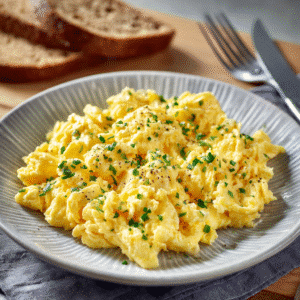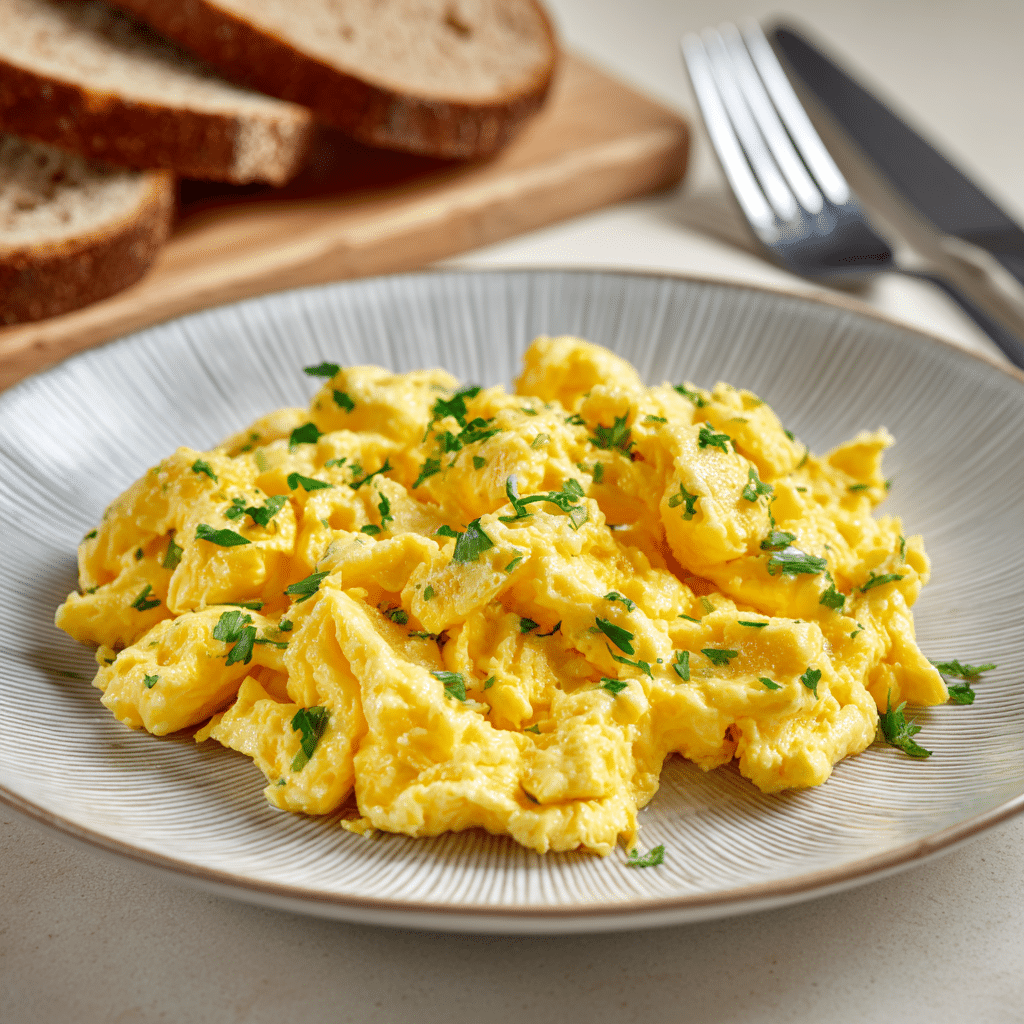Perfect scrambled eggs are soft, buttery, and irresistibly fluffy. Whether you enjoy them plain with a sprinkle of salt or topped with herbs, cheese, or veggies, scrambled eggs are a foundational breakfast dish that’s comforting, quick, and incredibly versatile.
This guide will teach you how to make rich, custard-like scrambled eggs just like a chef—with tips, techniques, and delicious variations that elevate this simple dish into something truly crave-worthy.
Ingredients Overview: The Key to Creamy Eggs
Each ingredient matters when making scrambled eggs that are tender and silky. Here’s a closer look:
Eggs
Use fresh, large eggs. For most servings, plan on 2–3 eggs per person. The fresher the eggs, the better the texture.
Milk or Cream (Optional)
-
Whole milk adds moisture and softness.
-
Heavy cream makes them ultra-rich and creamy.
-
You can skip dairy altogether—many chefs prefer pure eggs.
Butter
Butter coats the pan and adds a luxurious flavor. Use unsalted butter so you can control the seasoning. It also helps prevent sticking.
Salt & Pepper
Seasoning is key. Add salt before cooking for tender curds; pepper can be added before or after based on preference.
Optional Add-Ins
-
Fresh herbs (chives, parsley, dill)
-
Shredded cheese (cheddar, feta, goat cheese)
-
Cooked vegetables (mushrooms, spinach, tomatoes)
-
Protein (smoked salmon, bacon, ham)
Step-by-Step Instructions: How to Make Perfect Scrambled Eggs
Mastering scrambled eggs is all about low heat and patience.
1. Crack & Whisk the Eggs
-
Crack 4 large eggs into a bowl.
-
Add a pinch of salt and 1–2 tablespoons of milk or cream (optional).
-
Whisk vigorously until the whites and yolks are fully blended and slightly frothy.
Pro tip: Whisking introduces air for fluffier eggs.
2. Heat the Pan
-
Place a nonstick skillet over low to medium-low heat.
-
Add 1 tablespoon of unsalted butter and let it melt gently, coating the pan.
3. Cook Slowly & Stir Constantly
-
Pour in the whisked eggs.
-
Let sit for a few seconds until they start to set at the edges.
-
Use a silicone spatula to gently push the eggs from the edges toward the center.
Continue stirring slowly and gently, forming soft, glossy curds.
4. Remove Early
When eggs are mostly set but still slightly glossy and moist, remove from heat. Residual heat will finish cooking them.
5. Season & Serve
Add a crack of black pepper and any toppings you like. Serve immediately.
Tips, Variations, and Substitutions
Chef’s Tips
-
Low and slow: This is the golden rule for soft, tender eggs.
-
Don’t overcook: Eggs should be just set, not dry or rubbery.
-
Use a silicone spatula: It’s perfect for gentle stirring and prevents sticking.
Flavor Variations
-
Herbed Scramble: Add chopped chives or dill before serving.
-
Cheesy Eggs: Stir in grated cheese right after removing from heat.
-
Mediterranean: Add spinach, tomatoes, and crumbled feta.
-
Southwest: Add sautéed onions, bell peppers, and shredded cheddar.
Dietary Swaps
-
Dairy-Free: Use olive oil instead of butter, and skip the milk.
-
High-Protein: Use 1 whole egg + 2 egg whites for lighter macros.
-
Vegan: Use a chickpea flour scramble or tofu for a plant-based version.
Serving Ideas & Occasions
Scrambled eggs are endlessly adaptable. Here are a few favorite ways to serve them:
-
Classic Breakfast: With toast, crispy bacon, and fruit
-
Brunch Platter: Add roasted potatoes, avocado, and greens
-
Egg Sandwich: Pile into a toasted English muffin with cheese
-
On Toast: Top sourdough with scrambled eggs and chili crisp
-
With Grains: Serve over quinoa or brown rice for a hearty bowl
They also work great in wraps, burritos, and breakfast tacos.
Nutritional & Health Notes
Eggs are one of the most nutrient-dense foods you can eat. Here’s why scrambled eggs are a great start to your day:
-
Protein: 6–7g per egg, complete and high-quality
-
Healthy Fats: Especially if cooked with olive oil or ghee
-
Choline: Supports brain health and metabolism
-
Low Carb: Ideal for keto or low-carb diets
-
Vitamins: Rich in B12, D, A, and selenium
For a lighter version, use egg whites or reduce butter. For more fiber, serve with whole-grain toast or sautéed greens.
FAQ
1. Should I add milk or cream to scrambled eggs?
It’s optional. Milk or cream can add creaminess, but many chefs skip it to let the egg flavor shine. Use sparingly—too much makes them watery.
2. Why are my scrambled eggs rubbery?
Overcooking is the #1 culprit. Use low heat and remove the eggs from the pan while still slightly soft and glossy.
3. Can I make scrambled eggs ahead of time?
They’re best fresh, but you can make them ahead and reheat gently. Wrap in a tortilla or store in a breakfast sandwich for a meal-prep option.
4. What’s the best pan to use?
A non-stick skillet is ideal. Cast iron works too, but may require more oil or butter to prevent sticking.
5. Can I microwave scrambled eggs?
Yes, but stir every 30 seconds to avoid overcooking. Microwave eggs tend to be less fluffy but still tasty.
6. How do I make fluffy scrambled eggs?
-
Whisk eggs well to incorporate air
-
Use low heat
-
Don’t over-stir—gentle folding creates soft curds
-
Remove from heat early
7. Are scrambled eggs healthy?
Yes, especially when cooked with minimal fat and paired with veggies or whole grains. Eggs are a great source of protein and nutrients.
Tasty Recipes Card
Description:
Fluffy scrambled eggs made low and slow with butter, seasoning, and optional milk or cream. Perfect for any breakfast or brunch setup.
Ingredients:
-
4 large eggs
-
1–2 tbsp milk or cream (optional)
-
1 tbsp unsalted butter
-
Pinch of salt
-
Black pepper to taste
Instructions:
-
Whisk eggs with salt and milk until frothy.
-
Heat butter in a nonstick skillet over low heat.
-
Pour eggs into the pan and let sit for 10 seconds.
-
Gently stir with a spatula, pushing from edges to center.
-
Continue slowly stirring until soft curds form.
-
Remove from heat while still slightly glossy.
-
Season with black pepper and serve immediately.
Notes:
-
Add herbs, cheese, or sautéed veggies for variety.
-
Store cooked eggs in fridge for 1–2 days.
-
Best enjoyed fresh with toast, fruit, or grains.
Details:
Prep Time: 5 minutes
Cook Time: 5 minutes
Total Time: 10 minutes
Yield: 2 servings

